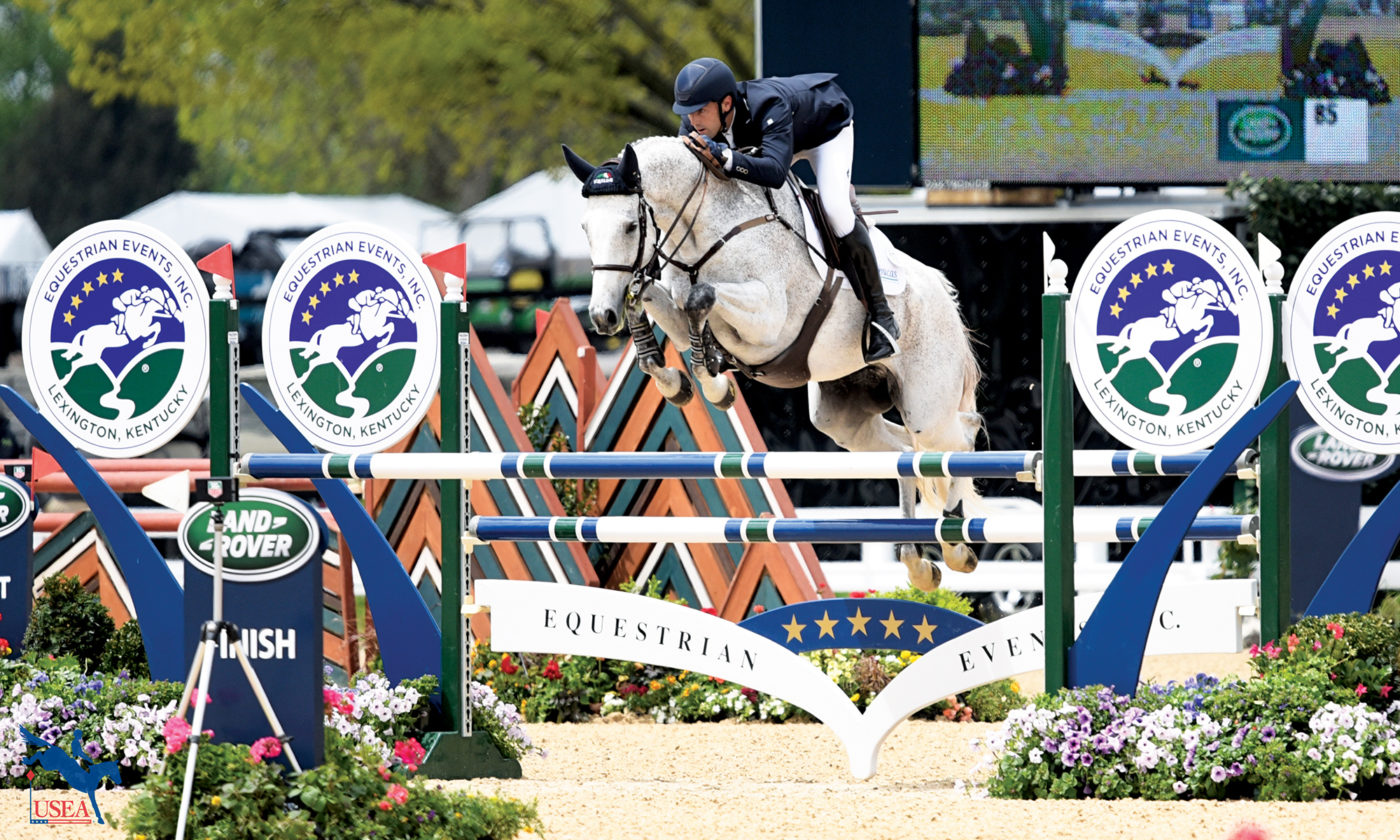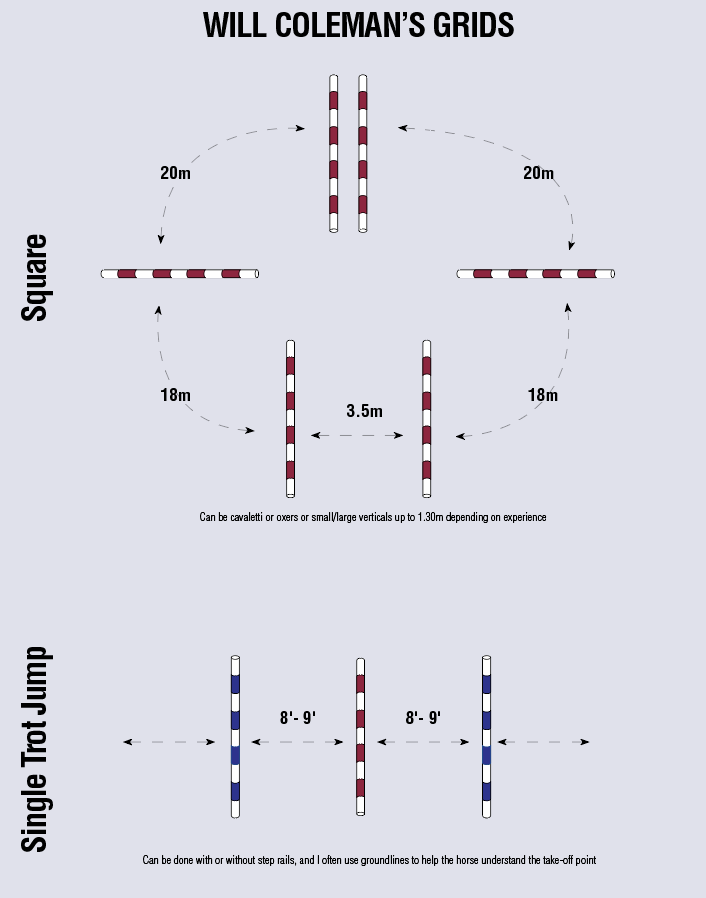Renew Your USEA Membership for the 2023 Season Today LEARN MORE

Ready to spice up your arena routine this winter training season? In this series, we are revisiting some of our favorite Grid Pro Quo articles from Eventing USA to help you use the off-season to your advantage and keep you and your horse in tip-top shape for when it's time to get back out there. Click here to check out other past Grid Pro Quo exercises!
Throughout my career, I’ve been lucky enough to both spectate and compete at some of the biggest events around the world. And whether you’re competing at one of these marquee events or at your local horse trials, the two biggest reasons that riders will have rails in show jumping are the same: lack of balance and rideability.
This box exercise is a classic rideability exercise that is good practice for improving your reaction, balance, and your eye. I use this exercise to help my students improve the harmony between them and their horses. Trotting a big vertical is a lesson in and of itself and is a valuable exercise for riders of all levels that I will often incorporate into my lessons throughout the year. And while this exercise is more of a mental one for the rider, it can be a good conditioning exercise for the horse to work on their hind end strength.
In my everyday training, I like to focus on the simple things. The efficacy of a traditional gymnastic exercise is oftentimes based on who you have on the ground. Otherwise it can be ineffective and sometimes confusing for the horse and rider. I have found that it is best to keep the exercises simple and just focus on doing them really, really well.
At the end of the day, if you can trot a decent-sized vertical, you and your horse will come away with a better technique. I will always start small and build the jump up gradually, but the goal is to be able to competently trot a vertical that could be 1.30m or higher, depending on the scope and experience of the horse. But remember that you don’t have to master this in one day! Since this exercise doesn’t take up a lot of room, you can leave it set up in your arena and go back to it at the beginning of each of your jump schooling sessions.

Before I even point my horse at the first pole on the ground I want to check off a few boxes in my head. First, I want to make sure that we’re communicating well. I want to feel like my horse is with me and listening and that we’re on the same page. At the same time I’m working to get my horse supple and relaxed while keeping my expectations realistic for their level of training. The biggest thing is that I want the feeling that my horse is thinking for themselves and happy in their work. And whether I’m jumping in the ring, outside of the ring, or just doing flatwork, the above checklist remains the same.
Once I check everything off my mental checklist, I will start by trotting a vertical at a warm-up height appropriate for my horse’s level a few times to get both my and my horse’s jumping muscles warmed up. Many people struggle with trotting tall verticals, but the great thing about this sometimes intimidating exercise is that when you get it right, you can really feel that it’s right, which is oftentimes more educational than having your instructor tell you “good job.”
If your horse is struggling with the trot vertical, you can add in step rails to help your horse understand where the take-off point should be. And don’t be afraid to adjust the distance between the jump and step rail. Some horses may need it at the traditional 9 feet, while others might do better with it at 8 feet. Just play around with it until you have it set to a distance where it best helps your horse.
After my students are successfully navigating the initial trot vertical exercise, I will begin the first pattern: trot the vertical, land in the canter and canter the square of cavaletti, then come back to the trot and jump the vertical one more time. While teaching, I always encourage my students to plan their own pattern and then stick to it as it’s good practice to not only think up your own courses, but sticking to your plan is great practice for shows where you don’t have time to throw in that extra circle or transition to reestablish rhythm and balance. Of course, if you need to add in that extra circle or transition the first time or two through your pattern, that’s fine. But make it a goal to land in the balance and rhythm needed to continue on with your pattern right away.
There’s no set formula for this exercise so don’t be afraid to mix it up. And while your goal is to execute your predetermined pattern right the first time, it’s completely okay to make mistakes. And when you do make a mistake, just take a moment to first figure out what went wrong and then make a plan for how to improve the next time.
The great thing about using this exercise as an instructor is that it really helps riders of all levels. While a beginner rider might struggle for a bit, there’s nothing stopping you from leaving the jump quite small and the cavaletti as poles on the ground for a long time. And if you’re struggling with the turns, you can set up cones or tennis balls to help you visualize where you need to me. And if you have a greener horse that may not have a lot of experience trotting jumps, you can put a placing rail in 9 feet before the vertical. This is an easy way to help explain the exercise to your horse.
Once you get to Preliminary, you should have some technical skills that are hopefully fairly reliable. This exercise should be reinforcing those things, and if not, you should think about taking a step back and perfecting these skills before moving back up.
If things are going really well with this exercise and you want to add a bit of a challenge, you have a few options. One option is to play about with the setup of your square of cavaletti. You can mix things up by replacing two of the cavaletti with oxers, or verticals. The height and width of the oxers and height of the vertical can vary depending on your experience level. Another option is to set this up out in a field where terrain will add to the exercise. While your goal is for there to be no change from the arena to the field, depending on your horse you may have to take a few steps back after moving outside and build it back up.
Truly, there’s no place where this exercise is out of place! Over the years I’ve found that it’s a great exercise to help center your body and mind with your horse. And if you practice it enough, you’ll notice that your horse may start to get a relaxed focus on the jump, which is just what we want.
A lifelong horseman, Will Coleman is based at Tivoli Farm in Gordonsville, Virginia. Throughout his career he has competed at some of the world’s most prestigious events and has also been on both an Olympic and World Equestrian Games team representing the U.S. While training and competing horses are Coleman’s passion and priority, he teaches lessons almost every day and clinics around the country. To learn more about Will Coleman, visit www.willcolemanequestrian.com.